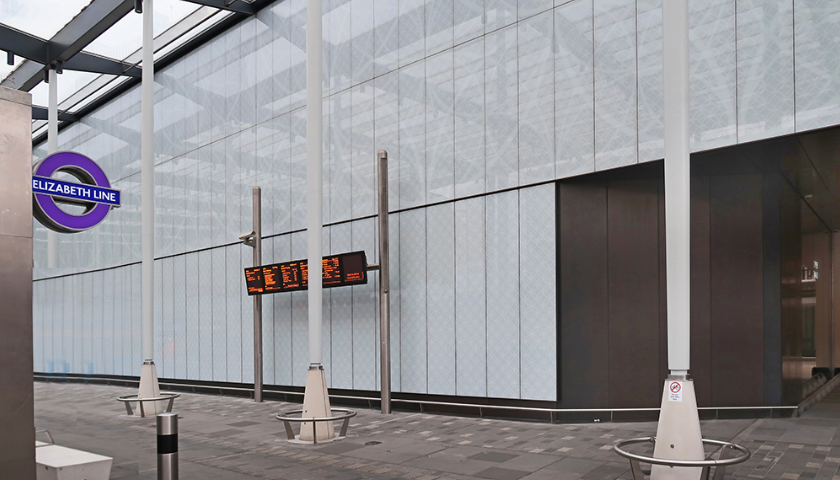The specification of a StoVentec Glass cladding solution at London’s new Paddington Elizabeth line station has highlighted the growing popularity of this system for use at transport hubs such as rail stations and airports. Paddington is the latest in a growing list of transport sector projects where StoVentec Glass has been installed, and it underlines the system’s ability to satisfy the very specific and demanding requirements of this type of application.
Specified by Weston Williamson + Partners, the StoVentec Glass system was installed in a large public area which leads onto the main station concourse, and the StoVentec Glass panels were screen-printed with a circular, patterned design. “Transport infrastructure projects impose a fairly rigid set of requirements on any construction material, and that is particularly true of glass,” comments Sto’s Product Manager, Greg Astill. “Safety, sustainability and the ability to accommodate a wide variety of design requirements, especially on refurbishment projects where existing structures are involved, are just some of the key requirements, and StoVentec Glass is able to satisfy all these, and many more.”
Recently relaunched, the next generation StoVentec Glass A is suitable for use either as an external rainscreen cladding system or as part of an interior design scheme, and is the only UK system with a BBA certificate for all standard applications. This includes independent assessment of wind loads, reaction to fire, safety and durability. Rigorous testing under extreme conditions has proved that StoVentec Glass A meets NHBC standards and Building Regulations, including a reaction to fire classification of A2-s1, d0, and has a minimum durability of 30 years – an important factor for high profile projects such as Paddington Station. “The system is perfect for use in high traffic areas as the glass has passed all industry standard soft-body and hard-body impact tests, in accordance with CWCT requirements,” adds Greg. It also has excellent impact performance and has passed stringent bomb blast tests in accordance with the latest ASIAD, SIDOS and CPNI requirements.
In terms of sustainability, StoVentec Glass A façades are extremely hard-wearing and weather-resistant, with the panel carrier boards manufactured using natural perlite. From a design perspective, the ability to specify any RAL or custom colour, bespoke sizes and shapes, and to screen-print logos and designs onto the glass provides the sort of versatility and flexibility that is often desired for transport station projects. The manufacturing process includes the fusing of colours on to the back of the glass, before the toughening process. The colour melts into the glass providing permanent coloured glass panels that will not wear, scratch, fade, or incur water damage.
“Sto’s technical and design team offer great support, right from the initial stages through to the completion of the projects,” adds Graham Chadwick of Craft Interior, Sto’s authorized applicator who installed the StoVentec Glass system at Paddington station. “As everything is manufactured on a bespoke basis, including the sub-construction design, joint detailing and penetrations, this helps remove any problems before they arise and ensures that the projects run smoothly.” Craft Interior have extensive experience of the StoVentec Glass system, having installed it on a wide range of transport sector projects ranging from internal ticket halls to external lift shafts.


